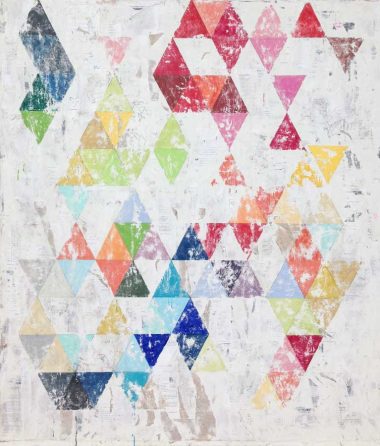Nicole Charbonnet’s layered paintings at Arthur Roger Gallery
By D. Eric Bookhardt, via bestofneworleans.com

Pattern (Climb Every Mountain No. 2), 2014-15
Acrylic, plaster and paper on canvas | 72 x 60 inches
In art, as in literature, time is the wild card. One generation’s genius is another’s kitsch as tastes and perspectives change. In some places, change happens as quickly as mood swings, but in New Orleans, change is as alluvial as the soil and new layers are added in organic increments. Here the surfaces of walls are like palimpsests, where old and new are eternally in flux. Initially, Nicole Charbonnet’s spectrally painted compositions with repeating patterns suggest the empty “zombie formalism” favored by Wall Street investors in recent years, but look again and microecosystems of words and images emerge from obscurity beneath painterly washes in works that utilize time like a tone or color.
Their pale, tactile patina evokes the whitewashed walls of sun-splashed places from the Vieux Carre to Spain’s Alhambra or Alexandria, Egypt. Pattern (Climb Every Mountain No. 2) (pictured) is a skein of polychrome geometry like a sandblasted wall in Saudi Arabia, but amid the austere lines are traceries of handwriting and other marks like lost notes or printed news dispatches. Pattern (Flowers No. 8) is more baroque, like floating clusters of faded blooms that might once have adorned the wallpaper of a local bordello, now derelict and discolored with the dampness of the ages. Pattern (Follow Every Rainbow No. 2) recalls the art deco frills of a Depression-era ballroom in a prairie ghost town. All of these works are tributes not just to what endures but to the way all that is new is given depth by all that came before.
That point is illustrated by the timeless modernism of Lin Emery’s consistent yet ever-evolving kinetic metal sculptures in the adjacent chamber — for instance, in the diademic dazzle of Flight or Fan Tree. Like George Dunbar, whose modernist vision is on view at the nearby Callan Contemporary, Emery was a co-founder of the Orleans Gallery, the utopian Royal Street co-op that anticipated by several decades the co-op artist spaces that now dot St. Claude Avenue.
